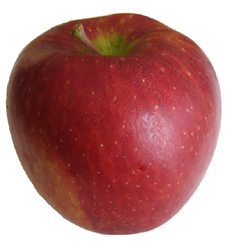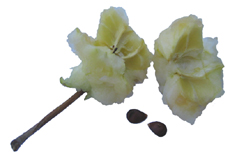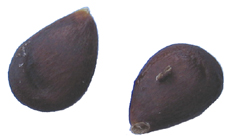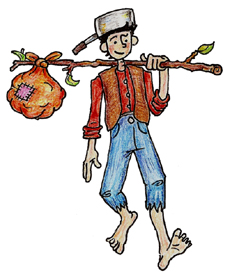Apples & Evolution
The
domesticated apple is economically the second most valuable fruit
grown in the United States,
second only to the orange (Wolford & Drusilla, 2007). Pollan (2001),
points out that Ralph Waldo Emerson once called the apple the “America
Fruit” (p. 6).
Johnny Appleseed, the “Big Apple”, “as American as
apple pie”. The apple certainly has made itself at home in America.
What are the true origins of the domestic apple?
 Flowering
plants made their first appearance in the fossil record during the
Cretaceous (Kenrick & Davis 2004, p. 195). The genus Malus most
likely arose in the Tertiary environments of what is now Southern
China.
Early Malus species
bore small fruits whose seeds were dispersed by birds. Large herbivores,
such as the horse
and bear, may have been involved in the early evolution and dispersal
of the sweet apple. Flowering
plants made their first appearance in the fossil record during the
Cretaceous (Kenrick & Davis 2004, p. 195). The genus Malus most
likely arose in the Tertiary environments of what is now Southern
China.
Early Malus species
bore small fruits whose seeds were dispersed by birds. Large herbivores,
such as the horse
and bear, may have been involved in the early evolution and dispersal
of the sweet apple.
The
proper scientific name for domesticated cultivars and wild varieties
of the sweet apple is
Malus pumila (Juniper and Mabberley 2006, p. 18).
Today mixed fruit forests with wild M. pumila can be found in
central and inner Asia. Natural fruit forests containing 80% M. pumila still
exist in the Tian Shan Mountains. As awareness and concern about our
monocultural practices spread, there is a growing interest in protecting
the genetic diversity that can be found in these natural settings (Browning
1998, p. 34).
 It
was once thought that the present day apple was the result of hybridization
and
human
selection.
Evidence
now suggests that the evolution of M. pumila was shaped by
the Tertiary geography, climate and ecology of what is now Southern
China
(Juniper & Mabberley
2006, p.17). The most up-to-date account can be found in Juniper and
Mabberley’s The Story of the Apple. The book is not
only well researched; it is a delight to read. Once M. pumila had
evolved to its present form, how did humans affect its success? It
was once thought that the present day apple was the result of hybridization
and
human
selection.
Evidence
now suggests that the evolution of M. pumila was shaped by
the Tertiary geography, climate and ecology of what is now Southern
China
(Juniper & Mabberley
2006, p.17). The most up-to-date account can be found in Juniper and
Mabberley’s The Story of the Apple. The book is not
only well researched; it is a delight to read. Once M. pumila had
evolved to its present form, how did humans affect its success?
Humans
spread M.
pumila from China, to Rome, to Northern Europe through
commerce and conquest. Apple trees were spread intentionally through
the grafting of trees to create orchards and unintentionally via the
consumption of apples and the subsequent dispersal
of seeds.  In order to germinate apple seeds need to be separated
from
the
core
tissue, which
has inhibitors to germination and be subject to extended periods of near
freezing temperatures. The need for 60 or more near freezing days before
germination is most likely an adaptation to the climates of Southern
China. As the sweet apple spread west it encountered new environments
with different selective pressures. Sexual reproduction via the production
of seeds most certainly produced M. pumila varieties better
suited to their new environments. In order to germinate apple seeds need to be separated
from
the
core
tissue, which
has inhibitors to germination and be subject to extended periods of near
freezing temperatures. The need for 60 or more near freezing days before
germination is most likely an adaptation to the climates of Southern
China. As the sweet apple spread west it encountered new environments
with different selective pressures. Sexual reproduction via the production
of seeds most certainly produced M. pumila varieties better
suited to their new environments.
European settlers brought M.
pumila to the Americas. Many of the European
grafted cultivars did not fair well (Pollen, 2001 p. 12). M. pumila more
than any other apple species exhibits incredible variation in the form
of its growth, leaves, and fruit.  Each seed is a unique genetic combination.
When this incredible variation is unleashed through planting from seed
it is inevitable that M. pumila will adapt to its surroundings. North
America became a great experimental station for the sweet apple; through
variation combined with both natural and artificial selection the apple
found a new home. The apple quickly became an important food source.
Pollen (2001) speculates that for early American colonists apples were
the main source of sweetness as sugar and honey were not widely available
(p.17). Dried apples retain their nutritional value and can be easily
stored. Dried apples were not only an important winter staple; they became
a valuable export. Apple evolution was influenced by humans need for
food; however, it was really accelerated by the need for liquid. Each seed is a unique genetic combination.
When this incredible variation is unleashed through planting from seed
it is inevitable that M. pumila will adapt to its surroundings. North
America became a great experimental station for the sweet apple; through
variation combined with both natural and artificial selection the apple
found a new home. The apple quickly became an important food source.
Pollen (2001) speculates that for early American colonists apples were
the main source of sweetness as sugar and honey were not widely available
(p.17). Dried apples retain their nutritional value and can be easily
stored. Dried apples were not only an important winter staple; they became
a valuable export. Apple evolution was influenced by humans need for
food; however, it was really accelerated by the need for liquid.
 John
Chapman (1774-1845), often referred to as Johnny Appleseed, helped make North America a testing ground
for seedling selection by
establishing apple orchards. Chapman
sold his trees mostly to pioneers settling in areas up and down the Ohio River Valley which includes the present day states of: Ohio, Indiana, Illinois, West Virginia, Pennsylvania, and Kentucky. Chapman’s seedlings
were only good in complying with land grant requirements for planting
fruit trees or growing apples for cider production (Pollen, 2001 pp.15-23).
Hard and soft cider was a critical beverage for Europeans and early American
colonists. Unpasteurized cider not only provides vitamin C, the fermentation
process creates vitamin B12. The alcohol and tannins in cider stop bacterial
growth, making it all the more important when water sources are unreliable.
Human cider production requires only the random apple trees produced
from seed. Seeds survive the production process, a fact of which Chapman
took advantage. Humans most certainly accelerated apple evolution though
cider production because at a local level it encouraged the growth of
apple trees from seed (Juniper & Mabberley,
2006 p. 161). John
Chapman (1774-1845), often referred to as Johnny Appleseed, helped make North America a testing ground
for seedling selection by
establishing apple orchards. Chapman
sold his trees mostly to pioneers settling in areas up and down the Ohio River Valley which includes the present day states of: Ohio, Indiana, Illinois, West Virginia, Pennsylvania, and Kentucky. Chapman’s seedlings
were only good in complying with land grant requirements for planting
fruit trees or growing apples for cider production (Pollen, 2001 pp.15-23).
Hard and soft cider was a critical beverage for Europeans and early American
colonists. Unpasteurized cider not only provides vitamin C, the fermentation
process creates vitamin B12. The alcohol and tannins in cider stop bacterial
growth, making it all the more important when water sources are unreliable.
Human cider production requires only the random apple trees produced
from seed. Seeds survive the production process, a fact of which Chapman
took advantage. Humans most certainly accelerated apple evolution though
cider production because at a local level it encouraged the growth of
apple trees from seed (Juniper & Mabberley,
2006 p. 161).
Although
humans have played a hand in sweet apple evolution Malus pumila remains
wild and genetically very similar to its wild form (Juniper & Mabberley,
2006 p. 183). Unlike cultivars that depend upon humans for survival
like corn, seedless
oranges,
banana,
etc.,
the
apple
retains
its
ability
to create great variation though sexual reproduction.
You can explore fascinating connections between the evolution of American apple orchards and the development of apple parers by reading Appeal to American Apple Parers: Historical Perspectives on Orchards and Yankee Ingenuity published in the Autumn 2016 issue of The Midwest Quarterly.
|

